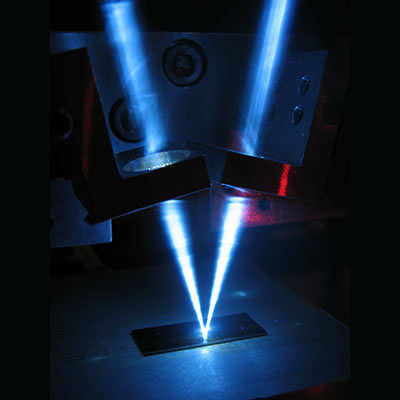Ytterbium-doped fibre amplifier
Southampton research pioneering high-power ytterbium-doped silica fibre lasers and amplifiers has enabled new high-energy manufacturing processes with a controlled carbon footprint.

Research challenge
Doping silica fibres with rare-earth metal ions creates a medium that can convert optical power from a semiconductor source into a finely focussed coherent laser beam. The University of Southampton led the development of low-loss doped silica fibres in the 1980s, trying out the full range of rare earth and other metals. The challenge was to identify metal ion dopants that absorbed light at the wavelength of the semiconductor sources, and converted the absorbed power efficiently into a coherent output beam, without wasting energy.
Context
For many purposes a laser beam is an ideal cutting tool. It does not get blunt and can cope with the toughest contemporary materials; it is contactless, and therefore safe to use on charge-sensitive structures like medical pacemakers; it cuts fast and is able to make an extremely fine and precise cut.
Traditionally, however, the energy cost of generating a suitable beam was high. Although semiconductor lasers can convert electrical power into light with good efficiency, they do not directly generate beams that can be focused finely enough for cutting.
Our solution
Southampton researchers were the first in the world to introduce ytterbium-doped silica fibres and to identify ytterbium as the optimum ion for efficient high-power fibre lasers and amplifiers.
The ytterbium-doped fibre is a light converter that absorbs raw infrared power from a semiconductor diode laser, and emits a bright, coherent beam that can be tightly focused for cutting, welding and material processing.
Research by Southampton professors Anne Tropper and David Hanna revealed the exceptional spectroscopic properties of the ytterbium ion in silica: it emits photons that are almost as energetic as those it absorbs, and it has very few pathways for wasting energy, even under the intense light field in the core of an optical fibre.
Their findings prompted world-wide interest in developing and commercialising these fibres and lasers.
What was the impact?
Ytterbium-doped silica fibre lasers and amplifiers have had a significant impact on the manufacturing industry.
Research by Anne and David triggered the birth of commercially available ytterbium-doped silica fibre light sources for materials processing and nonlinear optics, and prompted the creation of two spin-out companies Fianium and SPI Lasers.
Fianium was created more than a decade ago and has established itself as a global leader in the development and manufacture of ultrafast fibre lasers and laser systems that are used in a range of applications from illumination for keyhole surgery, to biomedical imaging techniques.
The company has an annual turnover of £10m and employs more than 50 people locally. It has been recognised for its achievements with two Queen’s awards – in 2009 for International Trade and in 2012 for Innovation.
It has also opened facilities in the USA and China and has established distribution networks in India, Korea, Russia, Israel and Sweden.
SPI Lasers was originally established to exploit Southampton-developed erbium-doped fibre technology but refocused its business in 2002 to concentrate on the design and production of ytterbium fibre lasers for manufacturing. Six years later German machine tool and disc laser specialist TRUMPF GmbH acquired the company for £27.8m. SPI now has an annual turnover of £50m, employs more than 250 people in the Southampton area, and exports more than 95 per cent of its products into Europe, the USA, and Asia.
The ytterbium-doped fibre laser has also had a major effect on the manufacturing industry particularly in the area of sheet metal cutting. A range of industries are benefitting from the technology including car manufacturers that are making safer vehicles from new materials that cannot be conventionally machined, aerospace companies that are able to reduce the weight and aerodynamic drag of their aircraft, and medical component manufacturers who exploit the spatial precision and contact free nature of laser machining in their production of stents, pacemakers and other life-saving devices.